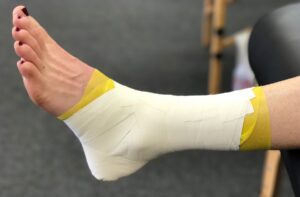Both taping and bracing play an important role in the prevention of ankle injuries and in the return to play of athletes with ankle injuries.
The question that is often asked by athletes with ankle injuries is which method is better? Is it better to tape an ankle or better to wear an ankle brace? The answer depends on a number of key factors. The first key issue is whether the athlete is dealing with a new injury or if the athlete’s goal is to prevent an ankle injury.
For the prevention of ankle injuries, the recommendation is for the athlete to purchase ankle braces.
The reasons for this include:
- Reduced cost of ankle braces versus purchasing athletic tape
- Reduced time for certified athletic trainers in preparing teams for practice/competition
- Ease of application
Although there is an initial cost of the ankle brace, braces save money as compared to purchasing athletic tape, prewrap, and heel and lace pads. With athletic budgets decreasing in high schools, colleges, and universities, athletic personnel are moving towards a one-time fee of ankle braces for preventing ankle injuries.
While some schools can afford to spend thousands of dollars on athletic tape, the majority do not have enough funds to supply the amount needed for preventative ankle taping for all of their athletes.
Time is also a consideration depending on the athlete’s access to a certified athletic trainer. There is usually a limited time for certified athletic trainers to prepare athletes for practice. Although certified athletic trainers can apply an ankle tape job fairly quickly, ankle braces can be applied by the athlete thereby reducing the workload of the sports medicine staff.
The most important factor when considering ankle braces is to get a brace that is effective in preventing inversion (rolling in) of the ankle. While there are many braces on the market, the ones that are effective have identifiable medial and lateral supports on both the inside and outside of the brace.
Last, the brace needs to be comfortable. An important lesson learned from the sports medicine profession is that if the brace is not comfortable, the athlete will not wear it. Because the design of ankle braces has improved over the years, braces are more comfortable today than in past years.
It is recommended that the athlete try on the ankle brace before purchase to make sure the brace fits comfortably on the athlete and in the athlete’s shoes. Some braces made with stiff metal supports are wide at the base of the foot and do not fit in to all athletic shoes.
What sports are athletes more at risk for ankle injuries?
It is generally recommended that athletes in sports where athletes frequently jump and land around multiple athletes (placing the ankle at risk for injury) be braced. These sports include volleyball and basketball. It is not uncommon to have coaches of these sports requiring all athletes to be either taped or braced on a daily basis.
When should an athlete be taped?
It is recommended that athletes with new or acute ankle injuries be taped until the ankle is stable enough for the athlete to practice and compete without support. The advantage of the athletic ankle tape job is that it can be custom designed for each athlete depending on the needs of the athlete.
ankle is stable enough for the athlete to practice and compete without support. The advantage of the athletic ankle tape job is that it can be custom designed for each athlete depending on the needs of the athlete.
Athletic tape jobs are effective as long as the athlete competes soon after the application of tape. Over time (after two hours), white athletic tape does stretch and loose some of its effectiveness. To combat this problem in the field, certified athletic trainers can reapply white tape if needed.
Certified athletic trainers are also trained in the application of advanced taping techniques using strong elastic tape. The specific advanced ankle tape procedure that can be applied to the ankle is called a “tape cast” because the elastic tape is applied in a way that prevents any inversion or eversion of the ankle.
Can dependence on athletic tape make the ankle weaker?
Athletes may become dependent on the secure feeling of being taped, but the tape itself does not weaken the ankle because the athlete may wear ankle tape for only two to three hours a day. However, the athlete is tape free during most of the day allowing the muscles around his/her ankle to continuously be engaged in righting the foot.
Both ankle tape and ankle braces play an important role in preventing injuries and in returning an athlete with an ankle injury to play. Knowing when to use athletic tape and when to use ankle braces is important to keeping athletes competing on the floor rather than sidelined with an injury.
References
Anderson, M., Parr, G., & Hall, S. (2009). Foundations of Athletic Training: Prevention, Assessment, and Management. (4th Ed.). Lippincott Williams & Wilkins: Philadelphia, PA.
Arnheim, D. & Prentice, W. (2000). Principles of Athletic Training. (10th Ed.). McGraw-Hill: Boston, MA.
